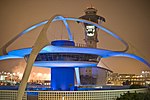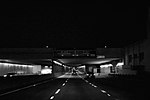Los Angeles World Airports
1928 establishments in CaliforniaAirport operators of the United StatesGovernment agencies established in 1928Government of Los AngelesLos Angeles International Airport ... and 1 more
Use mdy dates from November 2021

Los Angeles World Airports (LAWA) is the airport authority that owns and operates Los Angeles International Airport (LAX) and Van Nuys Airport (VNY) for the city of Los Angeles, California. LAWA also owns and manages aviation-related property near the Palmdale Regional Airport (PMD). The authority's headquarters are on the grounds of LAX in the Los Angeles neighborhood of Westchester.
Excerpt from the Wikipedia article Los Angeles World Airports (License: CC BY-SA 3.0, Authors, Images).Los Angeles World Airports
East Way, Los Angeles
Geographical coordinates (GPS) Address Nearby Places Show on map
Geographical coordinates (GPS)
| Latitude | Longitude |
|---|---|
| N 33.9428 ° | E -118.4026 ° |
Address
Terminal 6
East Way
90009 Los Angeles
California, United States
Open on Google Maps







